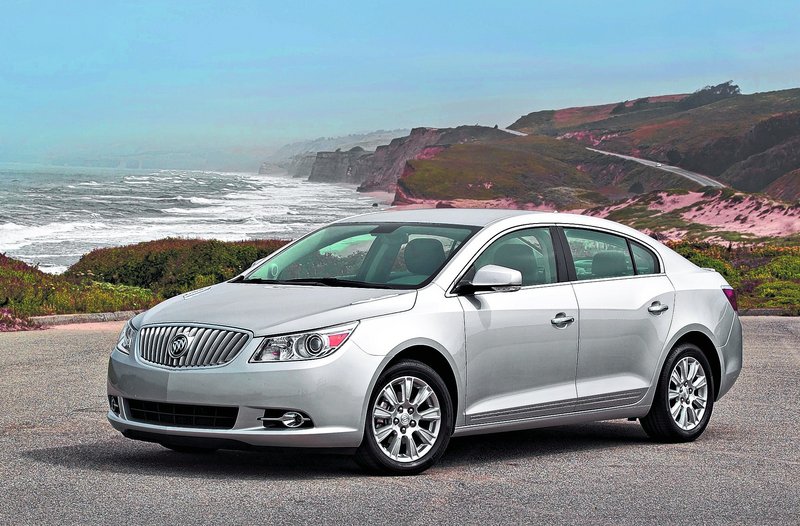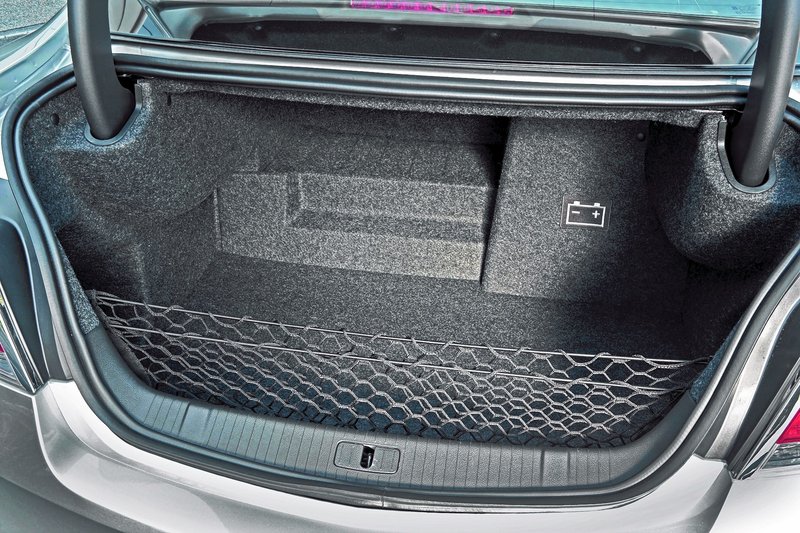The 2012 Buick LaCrosse appears to defy the laws of physics or the principles of automotive engineering … or simply the common belief that it is impossible to produce a large, luxurious sedan that doesn’t consume as much petroleum as a ballroom full of bodybuilders.
The last vehicle this large and luxurious that covered more miles on less fuel may have been a Wells Fargo stagecoach.
The LaCrosse, which became the vanguard for Buick’s new direction when it was redesigned for the 2010 model year, has plenty else going for it. But in a class filled with midsize winners such as Toyota’s Camry and Honda’s Accord, its most distinguishing feature is its ability to get better mileage than a Volkswagen Beetle — 25 city/36 highway mpg, according to the EPA.
That’s assuming the LaCrosse is equipped with what Buick calls “eAssist,” a gas/electric hybrid drive. General Motors describes it as a “light electrification” system because unlike most gas/electric hybrid cars, the LaCrosse can’t be propelled by electricity alone.
Instead, eAssist’s small electric motor/generator — which replaces a conventional starter motor and alternator — gives the LaCrosse’s 2.4-liter, four-cylinder gasoline engine a little extra oomph when driving conditions call for it.
For example, the gasoline engine’s 182 horsepower and 172 pounds-feet of torque alone might be more than adequate when the 4,000-pound LaCrosse is pulling out of a driveway or ambling along at 70 mph on the highway.
But during more demanding situations, such as highway merging or passing, the eAssist’s electric motor delivers (through a drive belt) up to 15 additional horsepower and 79 pounds-feet of torque to the LaCrosse’s front-wheel drive.
Think of it as the automotive equivalent of Popeye’s spinach… or as the “power-ups” found in countless video games, if you’re too young to remember Popeye.
The motor/generator also enables the gasoline engine to shut down when the LaCrosse isn’t moving and to reduce fuel delivery when it’s decelerating. Generally, I could tell when the motor/generator was restarting or reinvigorating the engine, but the shudder is very mild and unobtrusive.
Buyers who want more power and don’t mind 17 city/27 highway mpg, can opt for the 303-horsepower, 3.6-liter V6 that is available or standard on six of seven LaCrosse trim levels.
Although eAssist, which is standard on all four-cylinder 2012 LaCrosse models, accounts for most of the car’s 25-percent increase in fuel economy, there are other contributing factors:
Last year’s tires were replaced by low-rolling-resistance rubber.
A new six-speed transmission reportedly reduces friction loss.
New underbody panels and electronically controlled shutters in the front air vents improve aerodynamics.
A smaller fuel tank (15.7 gallons vs. last year’s 18.4) decreases weight.
A lower final gear ratio enables the engine to run at lower rpms on the highway.
Some of those changes would typically have an adverse effect on performance. For example, a smaller fuel tank reduces cruising range and lower final gear ratios can translate to more sluggish acceleration. But the extra power and fuel economy delivered by eAssist more than compensates, according to GM.
After driving a 2012 LaCrosse for a week, I can’t argue. The car averaged nearly 33 mpg in mostly highway driving, enabling it to go more than 500 miles between gas station visits.
Other cars get that kind of mileage, but they’re often “slug-muffins.” Not so for the LaCrosse, which I thought was powered by a six-cylinder until I got around to checking the specs. The LaCrosse is no missile, but I never felt deprived when accelerating from a stoplight or merging and passing on the highway.
I did notice, however, that it required cruise control or more attention than usual to maintain a steady speed on the interstate. The LaCrosse’s speed would slowly creep up or bleed off if I didn’t pay moderate attention to the speedometer and gas pedal.
The only other apparent drawback to eAssist is the space it eats up in the trunk. Even without eAssist, the LaCrosse’s 13.3 cubic-foot trunk is on the smallish size for a midsize sedan. But the 115-volt lithium-ion battery pack mounted between the LaCrosse eAssist’s rear seat and trunk reduces that considerably. It also reduces by about a third the width of the pass-through behind the folding rear seatbacks.
Combine that with a high and narrow trunk opening, and the LaCrosse turns into a not-so-great vehicle for trips to weekend hockey tournaments. I struggled to squeeze my son’s gear bag into the trunk and had to store one of our overnight bags in the rear seat.
But how many people have to transport a hockey goalie’s gear bag? Those who don’t will find the LaCrosse to be a refined, luxurious and competitively priced midsize that gets far better fuel economy than seems possible in such a car.
Scott Wasser is a freelance auto writer who can be reached at carguysw@aol.com.
Send questions/comments to the editors.




Success. Please wait for the page to reload. If the page does not reload within 5 seconds, please refresh the page.
Enter your email and password to access comments.
Hi, to comment on stories you must . This profile is in addition to your subscription and website login.
Already have a commenting profile? .
Invalid username/password.
Please check your email to confirm and complete your registration.
Only subscribers are eligible to post comments. Please subscribe or login first for digital access. Here’s why.
Use the form below to reset your password. When you've submitted your account email, we will send an email with a reset code.